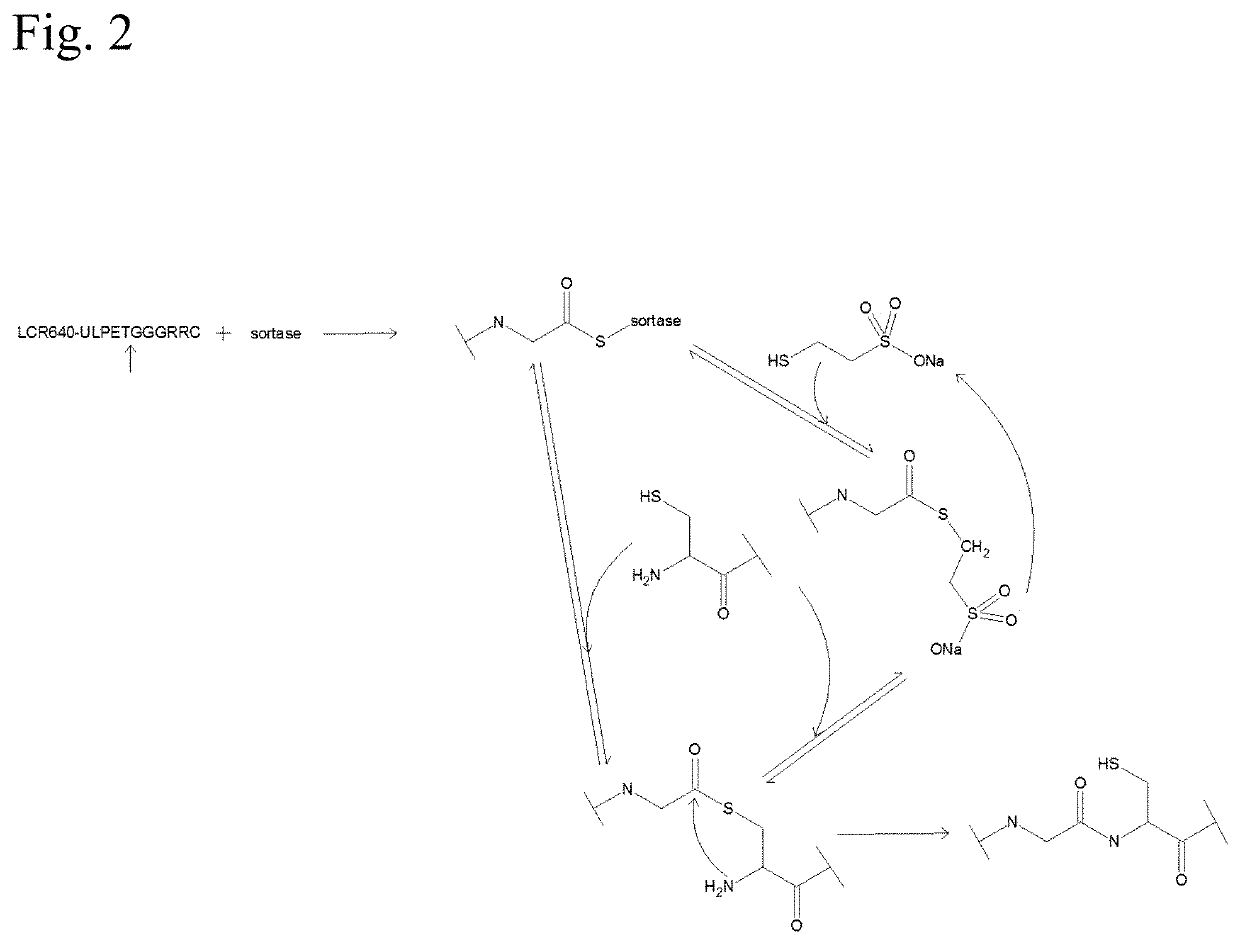Production of thioesters using sortase
a sortase and thioester technology, applied in the field of sortase-based thioester production, can solve the problem of unstable thioester
- Summary
- Abstract
- Description
- Claims
- Application Information
AI Technical Summary
Benefits of technology
Problems solved by technology
Method used
Image
Examples
example 1
Generation of an Expression Plasmid for Soluble S. aureus Sortase A
[0187]The sortase gene encodes an N-terminally truncated Staphylococcus aureus sortase A (60-206) molecule (amino acid sequence of SEQ ID NO: 05).
[0188]The expression plasmid for the expression of soluble sortase in E. coli cells comprised besides the soluble sortase expression cassette an origin of replication from the vector pUC18, which allows replication of this plasmid in E. coli, and the URA3 gene as selectable marker, and the Lad gene to allow induction of transcription using IPTG.
[0189]The transcription unit of the soluble sortase comprised the following functional elements:[0190]a T5 promoter,[0191]a purification tag,[0192]an N-terminally truncated S. aureus sortase A encoding nucleic acid, and[0193]the To and fd termination sequences.
[0194]The expression plasmid for the transient expression of soluble sortase in HEK293 cells comprised besides the soluble sortase expression cassette an origin of replication ...
example 2
Transient Expression and Analytical Characterization
E. coli:
[0205]The recombinant production of Sortase was performed by growing E. coli cells transformed with the respective Sortase expression plasmids to an OD578 of approx. 0.9 at 37° C. (pre-culture). At this OD578 of approx. 0.9 protein expression was induced by adding 2 mM IPTG and growing the cells for an additional 24 hours at 28° C. Thereafter, cells were harvested by centrifugation and lysed via high pressure using a homogenizer. Cell lysates were centrifuged to remove cell debris and subsequently the cell lysates were stored at reduced temperature (e.g. −80° C.) until purification. Soluble Sortase was purified using Ni-NTA chromatography followed by size exclusion chromatography. For depletion of endotoxins an anion exchange chromatography was performed in flow through mode. The protein concentration of sortase preparations was determined by measuring the optical density (OD) at 280 nm, using the molar extinction coeffici...
example 3
Sortase Mediated Conjugation
[0210]A reaction mixture comprising 0.5 mM of the polypeptide LCR640-ULPETGGGRRC (U: LCR640 fluorophore conjugated beta-alanine; SEQ ID NO: 33) Fc-region fragment comprising a LPETG sortase motif (SEQ ID NO: 04), 1.5 mM of an N-terminal biotinylated N-terminal cysteine comprising peptide with the C-terminally biotinylated amino acid sequence CAAA (SEQ ID NO: 03) and 50 μM Staphylococcus aureus Sortase A in 50 mM Tris pH 7.5, 150 mM NaCl, 10 mM CaCl2 was incubated at 37° C. for 18 hours.
[0211]In the samples were analyzed without stopping the reaction.
[0212]The samples (10 μl) were injected on a Vydac C18 column of an LC-Ms system and separated with a 30 min. linear gradient to 100% buffer B (buffer A (v / v): 95% water, 5% acetonitrile, 0.1% trifluoro acetic acid (TFA); buffer B (v / v): 5% water, 95% Acetonitrile, 0.1% TFA). The respective chromatogram is shown in FIG. 3.
[0213]The Analysis of the reaction mixture with LC-ESI-TOF-MS in positive ion mode shows ...
PUM
| Property | Measurement | Unit |
|---|---|---|
| temperature | aaaaa | aaaaa |
| pH | aaaaa | aaaaa |
| temperature | aaaaa | aaaaa |
Abstract
Description
Claims
Application Information
 Login to View More
Login to View More - R&D
- Intellectual Property
- Life Sciences
- Materials
- Tech Scout
- Unparalleled Data Quality
- Higher Quality Content
- 60% Fewer Hallucinations
Browse by: Latest US Patents, China's latest patents, Technical Efficacy Thesaurus, Application Domain, Technology Topic, Popular Technical Reports.
© 2025 PatSnap. All rights reserved.Legal|Privacy policy|Modern Slavery Act Transparency Statement|Sitemap|About US| Contact US: help@patsnap.com



